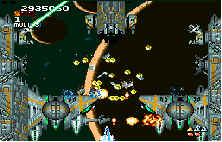 For shooter fans, just the
mention of a game developed by Compile will pump them up and have them talking about the
glory days of 16-bit gaming. I mean, who hasn't experienced the total exhiliration of such
epic blast-fests like M.U.S.H.A., Blazing Lazers and Zanac?
Curiously, Compile's best effort, Space Megaforce, has by and large been
ignored by a large segment of the gaming populace because it was made available for the
Super Nintendo – not exactly a system known for killer 2D shooters. But trust me when
I say this game (known as Super Aleste in Japan) is, bar none, THE best
16-bit overhead shooter that puts all others to shame.
For shooter fans, just the
mention of a game developed by Compile will pump them up and have them talking about the
glory days of 16-bit gaming. I mean, who hasn't experienced the total exhiliration of such
epic blast-fests like M.U.S.H.A., Blazing Lazers and Zanac?
Curiously, Compile's best effort, Space Megaforce, has by and large been
ignored by a large segment of the gaming populace because it was made available for the
Super Nintendo – not exactly a system known for killer 2D shooters. But trust me when
I say this game (known as Super Aleste in Japan) is, bar none, THE best
16-bit overhead shooter that puts all others to shame. Prior to migrating over to the SNES, the Aleste series had made appearances on the Sega Master System (as Power Strike in the U.S.) and the Soldier series on the PC Engine, and almost everything in between. The Aleste games showed the sprite capabilities of these machines better than anyone else. And, back in time when players were making fun of the SNES's processing speed (or lack thereof) - justified because of cases of severe slowdown in almost every first-generation shooter on the machine - along came Space Megaforce to banish any claims of Nintendo's 16-bitter's inferiority in this department.
Space Megaforce is exemplary in so many respects that it's difficult to point out its best virtue. For starters, its weapon system is unrivaled, even by contemporary 32-bit shooters. Besides the now-standard smart bomb at your disposal, there are eight possible upgradeable gadgets that you can pick up and add to your arsenal. Also very welcome is the freedom to change their attack mode at will. For example, you can choose between standard or less powerful heat-seeking missiles, or lock the position of the Gradius-style multiples. The sheer amount - and divesity - of firepower is was unprecedented for its time and still holds up well today.
Graphically, it holds up nicely against its counterparts. Explosions are huge and some of the special effects are trippy. Mode 7 graphics are used liberally, especially in the HUGE level 2 boss that scales in and out, and rotates smoothly. And check out the warping effect of the boss at the end of the Moonbase! I almost fainted when I first saw it. Backgrounds are nicely detailed and the SNES's color pallete is put to good use here. Overall, it's not as earth-shattering visually Konami's Axelay, but then again, nothing touches the sights in Axelay. On the audio side, Compile really took advange of the SNES's superior sound capabilities. Sound effects are crystal clear, and a dose of voice samples are thrown in for good measure. The techno tune has some rim-rattling bass that's arranged in stereo. The music is actually very cool and gets you pumped up. In fact, I'm looking for the Super Aleste music soundtrack, so if anyone knows where I can get one, let me know! Overall, Space Megaforce goes beyond the call of duty in the audiovisual department.
So what makes Space Megaforce better than other Compile shooters like M.U.S.H.A., Gunhead and Robo Aleste? First of all, In contrast to the aforementioned three titles and Spriggan on the PC Engine CD, the whole style is different. Whereas the others had unappealing fuedal-Japan mech enemies, Space Megaforce is an all-out space themed game that gives it a harder edge. The game also has more levels, better weapons, more enemies on-screen (without any slowdown), and each of the stages has much more variety than others put out by Compile. Add heaps of eye and ear candy and you have the most polished and playable 2D scrolling shooter.. perhaps ever.